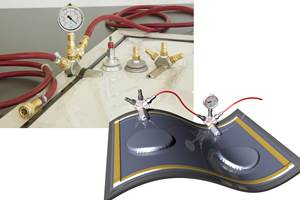Automated composites manufacturing, past, present and future
CW guest columnist Rob Sjostedt is a partner and CEO at VectorSum Inc. He recalls his days at Goldsworthy Engineering and reminds CW readers that today’s product requirements are more challenging than ever, and creative new approaches are required.
The 1970s and 1980s were dynamic periods in the development of automated composites manufacturing. In that time, Brandt Goldsworthy of Goldsworthy Engineering (Torrance, CA, US) and his team pioneered the first commercial pultrusion machines, and developed tape laying and fiber placement machines, numerous innovative custom machines and many variations of filament winding. I was fortunate to spend my early career working for and being mentored by Goldsworthy before becoming his company manager. It is interesting to look back and consider what has become of those pioneering efforts. Which pioneering processes have survived and become common today? Which processes still have unrealized potential? What are the future advancements in automated processing going to be?
Pultrusion has been one of the fastest growing commercial processes for some time. Pultruded products have clearly established their niche. Today’s machines have changed very little in concept from Goldsworthy’s original Glastruder. In-die injection is probably the most significant advancement since the process was commercialized. The addition of multiaxial fabrics has enabled pultrusion of more sophisticated laminates. Further development of lightweight and high-strength, yet cost-effective, profiles is the future challenge if pultrusion is to compete head-to-head with traditional materials. Joining pultruded profiles into large, integrated structures is another challenge that must be tackled.
Looking back, it is surprising that Pulforming, a Goldsworthy variation of the pultrusion process, has not been further developed or more broadly applied. Pulforming, which combines step compression molding with pultrusion material infeed technology, can enable continuous, automated manufacture of curved parts and parts with nonuniform cross sections. Maybe this recollection will inspire others to revisit the process and take it to the next level.
Goldsworthy made the first tape layer in the early 1970s and the first fiber placement machine in the mid-1980s, but both were hampered by machine-control technology limitations. The emergence of modern computer control/servomotor technology enabled these machines to become common, productive systems in aerospace. It is refreshing to note that probably the largest use of fiber placement is outside of the aerospace market. In the 1990s, North Sails (Milford, CT, US) applied the basic principles of large gantry-based fiber placement to sail manufacturing in a very big way. Literally thousands of fiber-reinforced sails have been made over configurable molds by the company’s unique 3DL process. North’s latest development, the 3Di process, is a true composite-laminate sail made using CAD and CAM. Goldsworthy would have been very pleased to see these developments! Maybe the same principles can be applied to large flexible architectural enclosures.
Southern Spars (Auckland, New Zealand) has applied tape laying to carbon fiber sailboat mast manufacture, and some of its projects are very large. Carbon fiber masts more than 46m tall are commonly made, and a recent project produced a 90m mast for a 90m yacht. These masts are stabilized with carbon fiber rigging made from bundled pultruded carbon rods or continuously wound rigging members. In the case of a 90m mast, the standing rigging elements are up to 90 mm in diameter with tensile strengths of more than 900,000 kg. These are serious engineering challenges, met using automated manufacturing technology.
Another Goldsworthy development with still unrealized potential is the combination of filament winding and pultrusion into one machine. Over-winding wheels upstream from a standard pultrusion machine enables manufacturers to make tubular products with optimized fiber orientations, and to do so on a continuous basis. With today’s materials and computer control systems, these technologies offer the opportunity to make high-performance tubulars for the oil and gas market in a cost-effective manner.
As product designers and manufacturing engineers work to develop future products, it is important to pick the right process or combination of processes. Today’s product requirements are more challenging than ever, and creative new processes and approaches are often required. At my current company, VectorSum Inc. (Irvine, CA, US), we strive to find the optimal solution from the rational combination of all constraints, requirements, expectations, capabilities and experience that constitute the boundary conditions of a problem. By imagining each of these determinants as a vector, the sum of the vectors defines the solution. This approach can lead one to step out of conventional practice and come up with creative system-engineering solutions. Much like Brandt Goldsworthy did in his lifetime of contribution to the composites industry.
Related Content
The state of recycled carbon fiber
As the need for carbon fiber rises, can recycling fill the gap?
Read MoreSmartValves offer improvements over traditional vacuum bag ports
Developed to resolve tilting and close-off issues, SmartValves eliminate cutting through vacuum bags while offering reduced process time and maintenance.
Read MoreNovel dry tape for liquid molded composites
MTorres seeks to enable next-gen aircraft and open new markets for composites with low-cost, high-permeability tapes and versatile, high-speed production lines.
Read MoreMFFD thermoplastic floor beams — OOA consolidation for next-gen TPC aerostructures
GKN Fokker and Mikrosam develop AFP for the Multifunctional Fuselage Demonstrator’s floor beams and OOA consolidation of 6-meter spars for TPC rudders, elevators and tails.
Read MoreRead Next
“Structured air” TPS safeguards composite structures
Powered by an 85% air/15% pure polyimide aerogel, Blueshift’s novel material system protects structures during transient thermal events from -200°C to beyond 2400°C for rockets, battery boxes and more.
Read MoreCFRP planing head: 50% less mass, 1.5 times faster rotation
Novel, modular design minimizes weight for high-precision cutting tools with faster production speeds.
Read MoreVIDEO: High-rate composites production for aerospace
Westlake Epoxy’s process on display at CAMX 2024 reduces cycle time from hours to just 15 minutes.
Read More






















